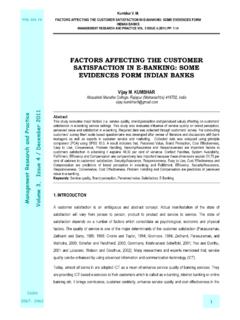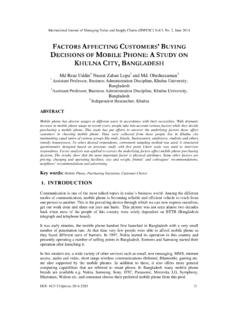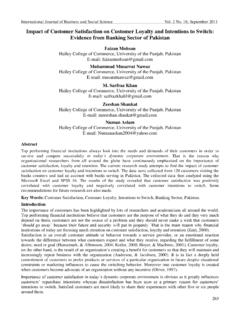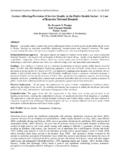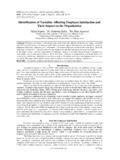Transcription of FILMTEC Membranes - Water Treatment Guide
1 FILMTEC MembranesFactors affecting ROMembrane PerformanceProduct Information*Trademark of The Dow Chemical CompanyFILMTECM embranes FILMTEC Corporation is a wholly owned subsidiary of The Dow Chemical osmosis (RO) technologycan be a complicated subject,particularly without an understandingof the specific terminology thatdescribes various aspects of ROsystem operation and therelationships between theseoperating bulletin defines some ofthese key terms and provides a briefoverview of the factors that affect theperformance of RO Membranes ,including pressure, temperature,feedwater salt concentration,permeate recovery, and system the percentage ofmembrane system feedwater thatemerges from the system as productwater or permeate. Membranesystem design is based on expectedfeedwater quality and recovery isfixed through initial adjustment ofvalves on the concentrate is often fixed at the highestlevel that maximizes permeate flowwhile preventing precipitation ofsuper-saturated salts within themembrane the percentage ofsolids concentration removed fromsystem feedwater by the the opposite of rejection, passage is thepercentage of dissolved constituents(contaminants) in the feedwaterallowed to pass through the purified productwater produced by a Feed flow is the rate offeedwater introduced to themembrane element, usuallymeasured in gallons per minute(gpm).
2 Concentrate flow is the rateof flow of non-permeated feedwaterthat exits the membrane concentrate contains most ofthe dissolved constituents originallycarried into the element from thefeed source. It is usually measuredin gallons per minute (gpm).Flux the rate of permeatetransported per unit of membranearea, usually measured in gallonsper square foot per day (gfd).Dilute solution purified watersolution, RO system product solution brackish Water solution such as ROsystem of pressureFeedwater pressure affects both thewater flux and salt rejection of ROmembranes. Osmosis is the flow ofwater across a membrane from thedilute side toward the concentratedsolution side. Reverse osmosistechnology involves application ofpressure to the feedwater stream toovercome the natural osmoticpressure. Pressure in excess of theosmotic pressure is applied to theconcentrated solution and the flow ofwater is reversed.
3 Aportion of thefeedwater (concentrated solution) isforced through the membrane toemerge as purified product Water of the dilute solution side (please seeFigure 1).Figure 1. Overview of Osmosis/Reverse OsmosisConcentratedSolutionDiluteSolutio nConcentratedSolutionConcentratedSolutio nDiluteSolutionPressureOSMOSISW ater diffuses through a semipermeable membrane toward region ofhigher concentration to equalize solution strength. At equilibrium, theheight difference between the concentrated and dilute sides correspondsto the osmotic pressure differential between the two OSMOSISA pplied pressure in excess of osmotic pressure reverses Water flowdirection. Hence, the term reverse osmosis. As shown in Figure 2, Water fluxacross the membrane increases indirect relationship to increases infeedwater pressure. Increasedfeedwater pressure also results inincreased salt rejection but, asFigure 2 demonstrates, therelationship is less direct than forwater RO Membranes areimperfect barriers to dissolved saltsin feedwater, there is always somesalt passage through the feedwater pressure is increased,this salt passage is increasinglyovercome as Water is pushedthrough the membrane at a fasterrate than salt can be , there is an upper limit tothe amount of salt that can beexcluded via increasing feedwaterpressure.
4 As the plateau in the saltrejection curve (Figure 2) indicates,above a certain pressure level, saltrejection no longer increases andsome salt flow remains coupled withwater flowing through the of temperatureAs Figure 3 demonstrates, membrane productivity is verysensitive to changes in feedwatertemperature. As Water temperatureincreases, Water flux increasesalmost linearly, due primarily to thehigher diffusion rate of Water throughthe feedwater temperaturealso results in lower salt rejection orhigher salt passage. This is due to ahigher diffusion rate for salt throughthe ability of a membrane totolerate elevated temperaturesincreases operating latitude and isalso important during cleaningoperations because it permits use ofstronger, faster cleaning is illustrated by the comparisonof the pH and temperature ranges ofFILMTEC FT30 thin-film compositemembrane and a cellulose acetate(CA) membrane in Figure of salt concentrationOsmotic pressure is a function of thetype and concentration of salts ororganics contained in feedwater.
5 Assalt concentration increases, so doesosmotic pressure. The amount offeedwater driving pressurenecessary to reverse the naturaldirection of osmotic flow is, therefore,largely determined by the level ofsalts in the 5 demonstrates that, if feedpressure remains constant, highersalt concentration results in lowermembrane Water flux. Theincreasing osmotic pressure offsetsthe feedwater driving pressure. Alsoillustrated in Figure 5 is the increasein salt passage through themembrane (decrease in rejection) asthe Water flux of recoveryAs shown in Figure 1, reverseosmosis occurs when the naturalosmotic flow between a dilutesolution and a concentrated solutionis reversed through application offeedwater pressure. If percentagerecovery is increased (and feedwaterpressure remains constant), the saltsin the residual feed become moreconcentrated and the natural osmoticpressure will increase until it is ashigh as the applied feed can negate the driving effect offeed pressure, slowing or halting thereverse osmosis process andcausing permeate flux and saltrejection to decrease and even stop(please see Figure 6).
6 The maximum percent recoverypossible in any RO system usuallydepends not on a limiting osmoticpressure, but on the concentration ofsalts present in the feedwater andtheir tendency to precipitate on themembrane surface as mineral most common sparingly solublesalts are calcium carbonate(limestone), calcium sulfate(gypsum), and silica. Chemicaltreatment of feedwater can be usedto inhibit mineral 2. Effect of FeedwaterPressure on Flux and SaltRejectionFigure 3. Effect of FeedwaterTemperature on Flux and SaltRejectionPermeate FluxSalt RejectionPressure Permeate Flux(constant pressure)Salt Rejection(constant flux)Temperature Effect of pHThe pH tolerance of various types ofRO Membranes can vary composite membranessuch as FILMTEC FT30 membraneare typically stable over a broaderpH range than cellulose acetate (CA) Membranes and, therefore, offergreater operating latitude (pleasesee Figure 4).
7 membrane salt rejectionperformance depends on pH. Waterflux may also be affected. Figure 7shows that Water flux and saltrejection for FILMTEC FT30membranes are essentially stableover a broad pH illustrated in Figure 4, thestability of FT30 membrane over abroad pH range permits stronger,faster, and more effective cleaningprocedures to be used compared learn 1-800-447-4369 to learn whyFILMTEC thin-film compositemembranes are the world s leadingmembrane for Water purificationsystems. To date, more than1,000,000 FILMTEC membraneshave been installed worldwide. Findout why 4. Comparison of Operating and Cleaning Parameters for FT30 Thin-Film Composite membrane and a CAMembraneFigure 5. Effect of Increasing SaltConcentration on Flux and SaltRejectionFigure 6. Effect of IncreasedRecovery on Flux and SaltRejectionFigure 7.
8 Effect of Feedwater pHon Water Flux and Salt Rejection1234567891011121314100908070605 0403020100 FILMTEC FT30 Cleaning LimitsOperating LimitsCleaning LimitsOperating LimitsCelluloseAcetatepH RangepH of most naturally occuring watersTemperature ( C)Permeate FluxSalt RejectionFeed Concentration Permeate FluxSalt RejectionRecovery Permeate FluxSalt RejectionpH *Trademark of The Dow Chemical CompanyForm No. 609-00055-498 XQRPCH 172-083-E-498 RFILMTEC MembranesFor more information about FILMTEC Membranes , call Dow Liquid Separations:North America ..1-800-447-4369 Latin America ..(+55) 11-5188-9345 Europe ..(+31) 20-691-6268 Japan ..(+81) 3-5460-2100 Pacific ..(+852) 2879-7261 : The use of this product in and of itself does not necessarily guarantee the removal of cysts and pathogens from Water . Effective cyst and pathogen reduction is dependent on the complete system design and on the operation and maintenance of the : No freedom from any patent owned by Seller or others is to be inferred.
9 Because use conditions and applicable laws may differ from onelocation to another and may change with time, Customer is responsible for determining whether products and the information in this document areappropriate for Customer s use and for ensuring that Customer s workplace and disposal practices are in compliance with applicable laws andother governmental enactments. Seller assumes no obligation or liability for the information in this document. NO WARRANTIES ARE GIVEN;ALL IMPLIED WARRANTIES OF MERCHANTABILITY OR FITNESS FOR A PARTICULAR PURPOSE ARE EXPRESSLY April 1998.
